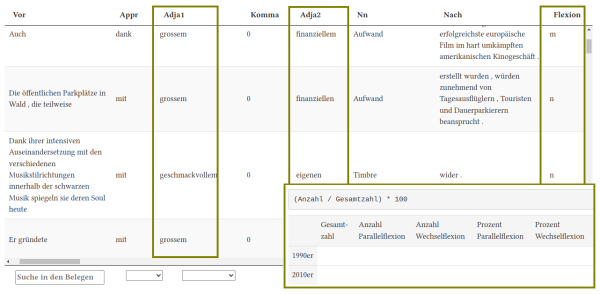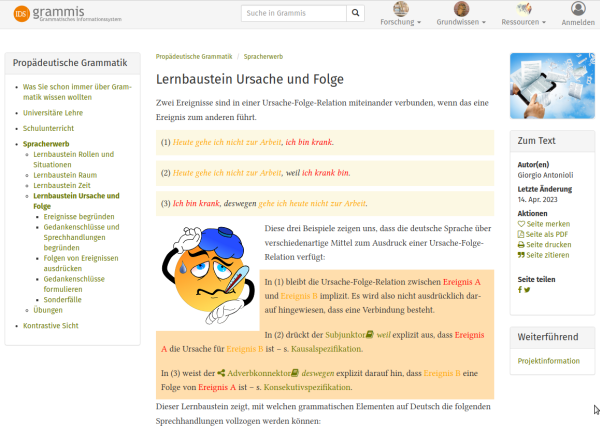Introducing Interactive Grammar: How to Develop Language Competence with Research-based Learning
urn:nbn:de:0009-5-57766
Zusammenfassung
Wir präsentieren die Implementierung einer interaktiven E-Learning-Plattform für das Lernen im Klassenzimmer und das Selbststudium, die dabei hilft, deutsche Sprachkompetenz – Wortschatz, Rechtschreibung und Grammatik – auf verschiedenen Ebenen und für alltägliche Anwendungen weiterzuentwickeln. Das LernGrammis-Portal richtet sich mit jeweils passenden Lerninhalten und interaktiven Bausteinen gleichermaßen an Schüler und Studierende, (angehende) Lehrkräfte und L2-Lernende der deutschen Sprache. Damit bietet es der digitalen Vernetzungsinfrastruktur für die Bildung eine einzigartige, frei verfügbare und wissenschaftlich fundierte Lernressource. Unter Anwendung des innovativen Konzepts des „Forschenden Lernens“ bietet LernGrammis Lehrkräften Ideen für die Unterrichtsplanung und Lernenden spezielle Module zur Entwicklung neuer Fähigkeiten durch die Erkundung authentischer Sprachressourcen und auf diese Weise die Beantwortung maßgeschneiderter, niedrigschwelliger Forschungsfragen. Anhand erprobter Praxisbeispiele demonstrieren wir den Ansatz, seine Stärken und Möglichkeiten sowie erste Auswertungsergebnisse von Nutzerfeedback.
Stichwörter: e-learning; Sprachwissen; Grammatik; Wortschatz; Rechtschreibung; Schulbildung; akademische Ausbildung; Spracherwerb
Abstract
We present the implementation of an interactive e-learning platform for both classroom study and self-study, that helps developing German language competence – vocabulary, spelling, and grammar – on various levels and for everyday life applications. The LernGrammis portal addresses school and highschool students, (prospective) teachers, and L2 learners of German equally, each with appropriate educational content and interactive components. It thus offers the digital networking infrastructure for education a unique, freely available and scientifically based learning resource. Applying the innovative concept of „Research-based Learning (RBL)“, LernGrammis provides teachers with ideas for lesson planning, and learners with dedicated modules to develop new skills through exploring authentic language resources and by this means answering customised low-threshold research questions. Using proven practical examples, we demonstrate the approach, its strengths and possibilities, as well as initial user feedback evaluation results.
Keywords: e-learning; Language Skills; Grammar; Vocabulary; Orthography; School Education; Academic Education; Language Acquisition;
1. Introduction and Motivation
Adequate reading and writing skills are indispensable for social participation on an equal footing. Language as a central means of communication not only enables us to interact under specific circumstances. It also contributes to social identification and is itself subject of public discourse. Competent learning assistance as well as self-reflective language use are therefore essential for speakers of German as a first (L1), second or foreign language (L2) in order to enhance their communication competence. This competence helps along in a variety of situations, depending on concrete life situation and needs: dealing with official business or planning leisure activities (to name some practical hurdles for language learners), but also preparing an effective speech or reflecting language variation (both are typical motivations for competent language users to deal with vocabulary and grammar). This is where LernGrammis – short for Lernzentrum Sprache: Grammatik interaktiv und systematisch (engl. Language learning center: Grammar interactively and systematically) comes in: a freely availabe and scientifically based online resource within the digital networking infrastructure for education, sustainably operated at the Leibniz Institute for the German Language (IDS), and tailor-made for school, study, vocational training, and the learning of German as a foreign/second language.
Rather than considering learning as a process by which ready-made knowledge is somehow „transferred“ from teachers to students, we apply the approach of „Research-based Learning“ (RBL). The principle has so far been used primarily in the academic field, see e.g. Mieg/Lehmann (2017), but seems reasonably transferable to other education sectors. It ties in with studies showing that terminology-focused grammar teaching can be cognitively overwhelming (Hochstadt 2021). RBL takes into account something we all know from everyday situations: that language is a dynamic and sometimes not entirely logical means of communication. On the one hand (for language beginners) the goal is about finding one's way in practice and avoiding misunderstandings, on the other hand (for competent speakers) it is about reflecting and deepening language competence.
The teaching philosophy behind RBL is expressed by the term „research“ and starts from the idea that stimulating education consists of thinking beyond rigid curricula. With RBL, learners develop new skills through answering customised low-threshold research questions. This approach was initially applied in many life sciences, but since linguistics nowadays also significantly relies on empirical data and methods, its transfer to language education has become immediately appropriate. LernGrammis encourages learners to use digital language resources and conduct their own experiments in order to solve given tasks that are integrated into thematic modules. For example, by querying authentic data collections (corpora) and interpreting the results, they put language phenomena they encounter in everyday life – e.g. „How do I form comparative and superlative adjectives in order to express differences between things?“ – into more abstract contexts and get a sense that language is not simply a set of rules and norms, but a living and manifold ecosystem with sometimes ambiguous situations. Positive effects of RBL, which can be seen as valuable keys to sucessful and sustainable learning, are thus the contextualisation of individual uncertainties, the critical comparison of norms and language reality, as well as the acquisition of problem-solving techniques and readiness for lifelong learning. Furthermore, the use of authentic material in realistic contexts seems to increase the intrinsic motivation of learners (García-Cabrero 2018). RBL‘s cognitive and affective-motivational implications are subject of empirical evaluations, see e.g. Wessels at al. (2021).
2 Content Selection
In order to didactically embed practical RBL steps, experimental „learning through research“ units should be accompanied by introductory material. To this end, LernGrammis builds on an established information portal (Grammis) with high coverage (https://grammis.ids-mannheim.de). Its content – specialist texts, frequently asked questions & answers, dictionaries, and data collections, as well as a comprehensive terminological framework – is based on leading linguistic research and educational standards, respectively, e.g. on a scientific grammar (Zifonun/Hoffmann/Strecker 1997) or the German language certificate of the Goethe Institute. This corresponds to new research findings that effective grammar and spelling instruction should rely on linguistically consistent samples and plausible models (see Fuhrhop/Reinken 2021). The system also includes basic grammatical information for the secondary education sector („Verzeichnis grundlegender grammatischer Fachausdrücke“), acknowledged by the Standing Conference of the Ministers of Education and Cultural Affairs („Kultusministerkonferenz“). The aim of this index is to provide clues for the conception of curricula and textbooks. As such, it provides a basis for standardizing grammatical terms and associated meanings. Correct spelling competence is supported through a hypertext version of the official set of rules, according to the recommendations of the Council for German Orthography, plus associated digital dictionaries. Overall, Grammis covers qualifications on crucial language levels (phonic, semantic, morpho-syntactic, pragmatic, discursive, literal; see Ehlich 2013).
Grammis is an online information system that enriches instructional materials according to the multimedia principle (Mayer 2017). It has been demonstrating for more than two decades how grammatical and spelling knowledge can be vividly conveyed using computer-based hypermedia (Schneider/Lang 2022). The idea is that traditional grammar books – however they are designed and however they may be theoretically oriented – quickly become so complex that their structure turns into a problem itself. Even experts often find it difficult to locate the information they need, not to mention the access problems that laypersons or language learners face. Classification and compilation of linguistic elements often remain unsatisfactory – e.g. because expressions that correspond syntactically can be classified quite differently from a functional point of view. Static references or indexes are of limited help here. Highly cross-linked dynamic systems such as Grammis, on the other hand, organize flexible access to digitized information for various user types. Within such a system, educational content can be arranged coherently, taking into account different user perspectives, interests and requirements.
Given this quality-assured pool of resources on all central areas of the German language, LernGrammis now has to decide how to set thematic priorities for the above mentioned education sectors (L1/L2). This seems fairly simple for primary and secondary schools, as well as for academic teacher training, where educational standards of the federal states provide an overall orientation framework. It becomes less straightforward for German as a Foreign Language (DaF) and German as a Second Language (DaZ). For the school sector, level descriptions for diagnosing L2 language competence („Niveaubeschreibungen Deutsch als Zweitsprache“) are available at federal state level, which in turn are based on curricula. Furthermore, there are joint initiatives with the Federal Ministry of Education and Research (BMBF), for example „Bildung durch Sprache und Schrift (BISS)“ and its follow-up initiatives (Becker-Mrotzek et al. 2022). But we see little guidance for adult education. The German Language Diploma („Deutsches Sprachdiplom“) does not seem to be a good fit here because it was designed as an examination programme for German as a foreign language abroad and requires years of attendance at German-speaking schools. More reasonable starting points are the learning objectives for language courses specified by the Federal Office for Migration and Refugees (BAMF), based on the Common European Framework of Reference for Languages (CEFR). The grammatical structures to be learned are not explicitly specified, but the approved textbooks are. These textbooks form the basis for the selection of thematic DaF/DaZ priorities in LernGrammis. Additionally, we acquire expertise from our international scientific advisory board as well as from relevant networks and user groups, e.g. through active members of the DGfS (German Linguistic Society) teaching initiative, and through feedback from university courses (education of prospective teachers for all education sectors) that use our resources.
Language learning includes dealing with grammatical topics, but also with lexical and pragmatic aspects, with references to diverse communication situations. To cover this broad spectrum, we draw on insights from the entire range of current German studies research in literature and linguistics (see e.g. Fuhrhop/Reinken/Schreiber 2023). Beyond given standards and curricula, our content selection is based on practical user needs, in particular by analyzing language advice services. For this purpose, we evaluate the „Question & Answer“ module within Grammis. It presents lists of frequently asked questions about the German language, and users are encouraged to mark unanswered questions as priorities. We also measure page impressions for identifying particularly popular questions and the associated language uncertainties. And finally, a large set of authentic language questions helps with the thematic prioritization. We evaluate more than 50,000 questions we have at hand, submitted by linguistic laymen to language consulting institutions over a period of two decades. For the empirical determination of linguistic cases of doubt – i.e. for identifying those areas in which many speakers/learners really „have a problem“ – this thematically classified data collection forms a unique and meaningful basis. Figure 1 illustrates that the perennial issues are spelling („Rechtschreibung“), grammar („Grammar“), lexis („Lexik“), and punctuation („Zeichensetzung“). These main categories can be further subdivided.
3 Implementation of Thematic Modules
LernGrammis offers both learning modules and prepared learning journeys to guide users through the system. Individual paths with uniform instructions and coherent content have thus far been difficult for users to create, which quickly leads to frustration and inefficient learning (Kirschner/Sweller/Clark 2006). In order to avoid informational overload, the internal module structure looks as follows: We place an introductory text at the beginning of each module in order to provide general information. It links to subordinate units, which develop the respective topic in detail. Each learning module is coherently closed. The above described recourse to curricula also offers the opportunity to at least approximately estimate learning time. Predefined paths can be used specifically for exam preparation.
In addition to textual content, LernGrammis includes graphics, sound, and animation. This allows to visualize characteristics of spoken language (e.g., stress ratios), grammatical structures (e.g., the conversion from active to passive voice), and the effects achieved by transforming these structures (e.g., through animated representations of temporal relationships or rearrangement tests). Figure 2 illustrates the connection and occasional overlap of the time period from which an event is viewed („Betrachtzeit“) and the time period from which the interpretation of the meaning of an utterance proceeds („Orientierungszeit“), used for an introduction to the future perfect tense.

Figure 2: Animated visualization for an introduction to the future perfect tense.
RBL as an approach to activate and motivate learners can be exemplified by the presentation of adjective inflection. After introducing the different inflection patterns and endings of adjectives in German, the corresponding LernGrammis module offers an in-depth unit where users are guided to empirically evaluate an corresponding hypothesis, saying: „The fluctuation between parallel and alternating inflection of adjectives is a case of language change.“ (see e.g. Nübling 2011 for details). The learners are introduced to an appropriate resource, namely the Database of Attributive Adjectives („Datenbank attributive Adjektive“). Handling and search options are explained in detail and with step-by-step pictures, so that the learners get an overview of the actual language use and can easily calculate a statistically valid statement about this phenomenon. Relative frequencies are used so that results can be interpreted diachronically for data samples of different sizes (see figure 3). Interested learners thus not only apply previously acquired knowledge, but also incidentally become familiar with strategies and scientific methods that support lifelong learning.
Modules at all levels are equipped with interactive exercises. The idea behind this is not just that language competence seems only determinable by judging actual performance. In particular, the exercises should promote reflection and application of grammatical knowledge and make its everyday relevance tangible. Their design is based on transferable evidence from empirical studies „that the implementation of grammatical tests in German studies has an indisputable benefit for the planning and conception of university teaching“ (Schäfer/Sayatz 2017, 241). Challenging exercises are also associated with a significantly higher „cognitive activation“ of learners (Lipowsky 2020). Ideally, they link with existing knowledge and – in situations that are unclear for a particular reason – show different solutions or variants. LernGrammis exercises are designed to make transfer success directly verifiable. They embed learning content into everyday life contexts, for example through the practical application of (morpho-)syntactic regularities or stylistic-semantic properties of certain words, word classes and word groups. Learners are encouraged to use their (meta-)linguistic competence in a productive way; teachers are provided with ideas and materials for lesson planning.

Figure 5: Animated visualization to support the formulation of cause-effect relationships.
Exercises can be of five different types: simple-choice/multiple-choice, gap-fill exercises, matching exercises, ordering exercises (e.g. of jumbled sentences), and crossword puzzles. They are connected to learning units that deal with typical linguistic means of expression – sometimes at a higher, sometimes at a lower terminological level (cf. Figure 4, which introduces some advanced vocabulary). They all can be completed online. Figure 5 illustrates the embedding within practical life and private contexts. The animated visualization introduces an everyday situation: an egg is fried in a pan. In order to support the description of cause-effect relationships using conjunctions like „um“ and infinitive phrases, learners are asked to complete a sentence: „Die Flamme ist hoch genug, …“ („The flame is high enough...“). Several choices are offered to finish the sentence in a meaningful way. Suitable in this case is: „um die Pfanne zu erhitzen.“ („to heat the pan.“)
Obviously, modules for language acquisition must cover key areas and promote basic language skills, as illustrated in the example above. Other competence areas include the asking and answering of questions („explain why“ with appropriate question words and sentence patterns) or the description of an observation (use of temporal, modal, final or consecutive sentence patterns). But LernGrammis here again also addresses advanced learners and instructors who want to focus special thematic emphases. Against this background, DaF/DaZ L2 modules include units on constructions and usage patterns in spoken German. E.g., a dedicated learning unit describes specific interactional uses of connectors like „also“ or „dann“. When formulating conclusions, they are used with varying meanings (e.g. „Also machen wir das so!“ vs. „Dann machen wir das so!“; see Antonioli 2016 for linguistic foundations).
All content (primary and meta data) is stored reliably and sustainably in a database management system. Learning units are consistently coded with semantic XML (Extensible Markup Language) element types. As a result, they are transferable to almost any desired technical format, and interconnection is enabled through open APIs (Application Programming Interfaces).
4 Evaluation
In accordance with privacy laws, we continuously evaluate approriateness and impact of Grammis and LernGrammis, respectively. Of course, such online statistics should not be overestimated as indicators for acceptance or even quality, just because they are easy to collect. Even small differences in technical implementation can make cross-system comparisons of different online portals difficult. As our web pages are compiled „on the fly“ from different data sources (SQL tables, XML instances, web services, multimedia files), almost each page impression triggers a multitude of server-side actions. In contrast to simple logfile analyses, that take into account all these actions, our web analytics application counts web pages generated in this way only once. Thus, the following evaluation of page impressions may serve as an approximately accurate usage indicator.
Monthly access numbers for the entire Grammis portal usually lie between 100,000 and 150,000 page impressions. Approximately 15 percent of these visits fall into the Propaedeutic Grammar section („Propädeutische Grammatik“), of which LernGrammis is a component. Negative peaks are regularly observed during the summer months and correspond to traditional vacation periods, cf. figure 6 (left side).
The digital LernGrammis portfolio was designed as a responsive web solution that adapts its layout to specifics of the technical user equipment. All modules should be conveniently explorable not only on desktop terminals with large screens, but also on mobile devices like smartphones and tablets. These tend to be used on the go, while people are looking up ad hoc information on the bus or train or during a lecture. Grammis visits via desktop PC take up to four times longer on average, and include three times more page views than smartphone visits. So It can be reasonably assumed that desktop computers tend to be used for more comprehensive searches, for example in order to produce an essay or to carry out complex paperwork. Desktop computers and notebooks currently still account for 60% of the overall visits. The share of smartphones has been increasing for the last years and is now around one third, with a steady slight increase. Other device types, such as tablets, do not play a significant role, cf. figure 6 (right side).
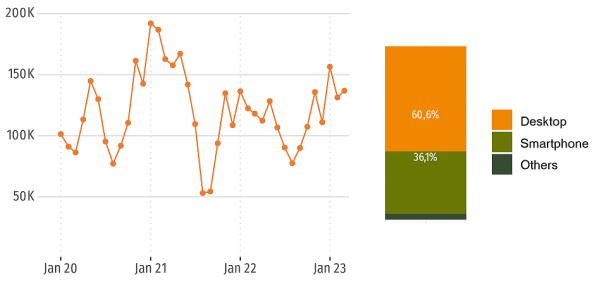
Figure 6: Time curve of page impressions (left) and breakdown of technical devices (right).
In order to better assess various user groups and to adapt LernGrammis accordingly to their needs, we are evaluating the system in form of an online survey. Results are analyzed at project start time as well as towards the end of the funding period. As part of our diverse networking activities (e.g., during visits at schools and universities or during presentations at network meetings and conferences), we invite people to respond to the quite elaborated questionnaire. We also draw attention to the survey via social media. In the following, we present an initial evaluation (5 of about 30 questions asked) after four months of active project work. It should be noted that the data sample available so far (39 fully completed surveys and several hundred incomplete responses) does not yet permit many valid interpretations. Part of the results may be attributable to statistical bias, since the sample could not be obtained through random selection from the target population. Inevitably at the current project stage, most actively addressed users primarily come from the academic field and teacher education. As will become clear, this is presumably reflected in several responses.
The following diagrams provide information about primary user groups, previous knowledge, and expectations. Figure 7 illustrates that the majority of survey participants (so far) are teachers (65%). Figure 8 breaks down the spectrum and shows that most of them give lessons at universities (55%), followed by schools (32%) and L2 institutions (13%). The distribution of multiple-choice answers to the question, which grammar types were already known and used before, spreads more widely as may be expected: the ranking is – scarcely surprising – led by school grammars (e.g., the „Duden“ as probably most popular reference book in this field) with 30%. Here, one might have expected even higher values. Immediately after that, grammatical online resources are mentioned (27%), and almost equally scientific grammars (25%). Specific grammar workbooks follow last (18%), cf. Figure 9.
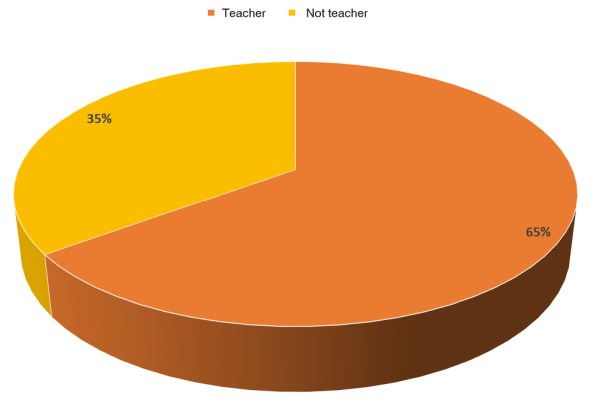
Figure 7: Reported occupations of users.
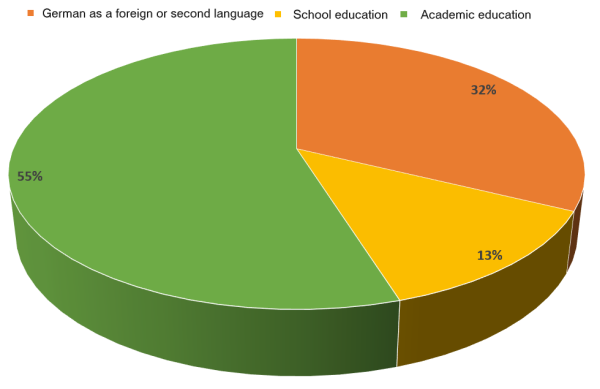
Figure 8: Reported education sectors.
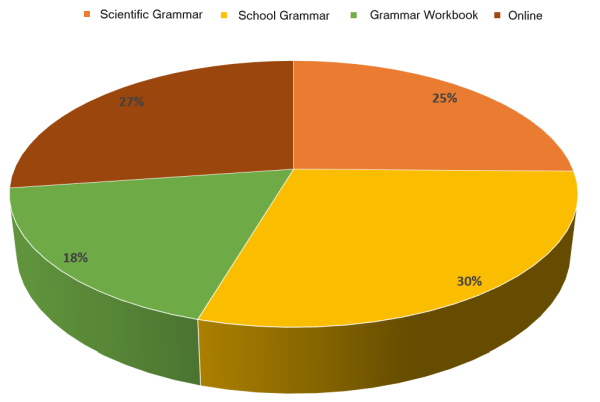
Figure 9: Previously known grammar types.
We also asked users about expectations and their fulfillment through our learning and information offerings. Three possible expectations („Help with language problems“, „Introduction to grammar research and scientific background information“, „Finding a solution for a specific problem or question“) and their fulfillment were put up for selection. Figure 10 shows that for the vast majority of users these expectations were met.

Figure 10: Fulfillment of expectations (absolute values).

Figure 11: Importance and appropriateness of multimedia content (absolute values).
Finally, figure 11 illustrates user feedback concerning importance and appropriateness of multimedia content within the system. For a great majority, the use of multimedia such as graphics, audiovisual content or animations is clearly important to achieve their learning/teaching goals. LernGrammis seems to have room for improvement here: When asked whether the possibilities of multimedia support are already being optimally exploited, a slightly narrower majority answered „probably yes“.
5 Conclusion and Outlook
The LernGrammis portal addresses a broad range of L1/L2 learners of German, each with appropriate educational content and interactive components, as well as teachers. It offers material for self-study, classroom study, and lesson preparation. It is based on curricular standards – if available –, scientific evaluation, and practical experience. A big plus is the incorporation of authentic language resources (e.g., corpora, databases, dictionaries) and terminological knowledge from the Leibniz Institute for the German Language (IDS), combined with the concept of „Research-based Learning“. Thus, the digital networking infrastructure for education gets a sustainable, freely available and scientifically based learning resource. Our present evaluation yields some first statements on user expectations, system approriateness and impact. As project work progresses, we are confident that in-depth analyses of the online questionnaire will be built upon a more informative data sample and more robust indicators.
Bibliography
Antonioli, G.: Konnektoren im gesprochenen Deutsch. Eine Untersuchung am Beispiel der kommunikativen Gattung «autobiographisches Interview». Deutsche Sprachwissenschaft International 23. Lang, Frankfurt am Main, Berlin, Bern, Bruxelles, New York, Oxford, Wien, 2016. https://doi.org/10.3726/978-3-653-06935-8 (last check 2023-09-05)
Becker-Mrotzek, M.; Roth, H.-J.; Grießbach, J.; von Dewitz, N.; Schöneberger, C. (Ed.): Sprachliche Bildung im Transfer: Konzepte der Sprach- und Schriftsprachförderung weitergeben. Kohlhammer, Stuttgart, 2022.
Ehlich, K.: Sprachliche Basisqualifikationen, ihre Aneignung und die Schule. In: DDS – Die Deutsche Schule, 105(2), 2013, pp. 199-209. https://doi.org/10.25656/01:25753 (last check 2023-09-05)
Fuhrhop, N.; Reinken, N.; Schreiber, N. (Ed.): Literarische Grammatik. Wie Literatur- und Sprachwissenschaft voneinander profitieren können. Germanistische Bibliothek 78. Winter, Heidelberg, 2023. https://doi.org/10.33675/2023-82538608 (last check 2023-09-05)
Fuhrhop, N.; Reinken, N.: Minimalistischer Orthographieunterricht. In: Müller, H.-G.; Kepser, M.; Schallenberger, F. S. (Ed.): Neue Wege des Orthografieerwerbs. Forschung – Vermittlung – Reflexion. Lemberger, Wien, 2021, pp. 9-21.
García-Cabrero, B.; Hoover, M.; Lajoie, S.; Andrade-Santoyo, N.; Quevedo-Rodríguez, L.; Wong, J.: Design of a learning-centered online environment: A cognitive apprenticeship approach. In: Educational Technology Research and Development, 66 (3), 2018, pp. 813-835. https://doi.org/10.1007/s11423-018-9582-1 (last check 2023-09-05)
Hochstadt, C.: Rahmenlos – Zum Verzeichnis grundlegender grammatischer Fachausdrücke. In: Didaktik Deutsch 51/2021, 2021, pp. 5-10. https://paedagogik.de/didaktik-deutsch/product/didaktik-deutsch-heft-51-2021-2296/ (last check 2023-09-05)
Kirschner, P. A.; Sweller, J.; Clark, R. E.: Why Minimal Guidance During Instruction Does Not Work: An Analysis of the Failure of Constructivist, Discovery, Problem-Based, Experiential, and Inquiry-Based Teaching. In: Educational Psychologist 41(2), 2006, pp. 75-86. https://doi.org/10.1207/s15326985ep4102_1 (last check 2023-09-05)
Lipowsky, F.: Unterricht. In: Wild, E.; Möller, J. (Ed.): Pädagogische Psychologie. Springer, Berlin, Heidelberg, 2020, pp. 69-118. https://doi.org/10.1007/978-3-662-61403-7_4 (last check 2023-09-05)
Mayer, R. E.: Using multimedia for e‐learning. In: Journal of Computer Assisted Learning, 33 (5), 2017, pp. 403-423. https://doi.org/10.1111/jcal.12197 (last check 2023-09-05)
Mieg, H.; Lehmann, J. (Ed.): Forschendes Lernen: Wie die Lehre in Universität und Fachhochschule erneuert werden kann. Frankfurt am Main, Campus Verlag, 2017.
Nübling, D.: Unter großem persönlichem oder persönlichen Einsatz? Der sprachliche Zweifelsfall adjektivischer Parallel- vs. Wechselflexion als Beispiel für aktuellen grammatischen Wandel. In: Köpcke, K-M.; Ziegler, A. (Ed.): Grammatik – Lehren, Lernen, Verstehen. Zugänge zur Grammatik des Gegenwartsdeutschen. de Gruyter, Berlin, Boston, 2011, pp. 175-195. https://doi.org/10.1515/9783110263183 (last check 2023-09-05)
Schäfer, R.; Sayatz, U.: Wie viel Grammatik braucht das Germanistikstudium? In: Zeitschrift für germanistische Linguistik, 42(2). de Gruyter, Berlin, Boston 2017, pp. 221-255. https://doi.org/10.1515/zgl-2017-0012 (last check 2023-09-05)
Schneider, R.; Lang, C.: Das grammatische Informationssystem grammis – Inhalte, Anwendungen und Perspektiven. In: Zeitschrift für germanistische Linguistik, 50(2), 2022, pp. 407-427. https://doi.org/10.1515/zgl-2022-2060 (last check 2023-09-05)
Wessels, I.; Rueß, J.; Gess, C.; Deicke, W.; Ziegler, M.: Is research-based learning effective? Evidence from a pre-post analysis in the social sciences. In: Studies in Higher Education, 46(12), 2021, pp. 2595-2609, https://doi.org/10.1080/03075079.2020.1739014 (last check 2023-09-05)
Zifonun, G.; Hoffmann, L.; Strecker, B.: Grammatik der deutschen Sprache. de Gruyter, Berlin, 1997.

